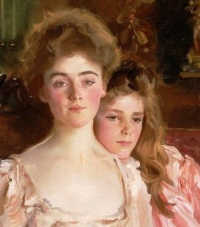 I love evolutionary biology, so I love this argument: Beauty is more valuable to girls than it is to boys, so beautiful parents should have more daughters than sons. You want (or at least your genes want) to pass on your assets to children who can make the best use of them.
I love evolutionary biology, so I love this argument: Beauty is more valuable to girls than it is to boys, so beautiful parents should have more daughters than sons. You want (or at least your genes want) to pass on your assets to children who can make the best use of them.
So I was delighted by recent news reports that beautiful women do indeed have more daughters. But I was stunned by the reported magnitude of the effect: According to one report, beautiful people are 36 percent more likely to have a daughter than a son!
If that’s true, it throws a whole new light on certain divorce statistics. On average, parents of daughters are more likely to divorce, and I’ve argued (here, here and here, citing research by Gordon Dahl and Enrico Morretti) that daughters probably cause divorce. But now we have a rival theory: Perhaps beauty causes both divorce and daughters.
It’s not hard to see how beauty might (on average) cause divorce; for example, it seems likely that the proverbial “trophy wives” are both disproportionately beautiful and disproportionately likely to be dumped when their beauty fades. So if the beautiful really have 36 percent more daughters, that’s plenty big enough to explain the daughter/divorce correlation.
But I don’t believe it. First, the “36 percent” number is just sloppy reporting. The actual number—which I found in the original paper by Satoshi Kanazawa of the London School of Economics—is 26 percent. (He’s also written a book on this and related research, which I have not read.)
Twenty-six percent is still huge. But it’s also probably spurious. For starters, the sample size is pretty small. Professor Kanazawa started with a sample of about 3000 women, rated from 1 to 5 on attractiveness. (I’ll tell you later where the ratings came from.) Of these women, about 350 were rated 5, and it’s true that these women had a great preponderance of daughters. But that’s a pretty small sample—small enough that there’s about a 5% chance the result is just a statistical fluke. (By contrast the
daughters/divorce study by Dahl and Moretti was based on a sample—drawn from census data—of 3 million.)
Worse yet, those women rated 4 (“attractive” as opposed to “very attractive”) had a great preponderance of sons. Sons were in fact much more common among both the “unattractive” 2’s and the “attractive” 4’s, while daughters were much more common among the 5’s. Among the 1’s and 3’s (“very unattractive” and “average”), the sex ratio is 50/50. Not much of a pattern there.
In fact, Professor Kanazawa’s strong result relies crucially on the fact that he lumped the 1’s, 2’s, 3’s and 4’s into a single category and compared them to the 5’s. If he had lumped the 4’s and 5’s together into a single category called “above average”, he’d have gotten a very different result.
In fact, there are a lot of ways to lump these data, and each way of lumping them gives you another shot at finding a statistical fluke. Given that the sample size makes flukes pretty likely to begin with, it’s not at all unlikely that the professor managed to stumble across one.
And there’s another problem. The sample consists of mothers who were interviewed about their families and then rated for attractiveness by the interviewer. It is not at all implausible to me that a mother talking about her daughter–or holding a little girl on her lap—might present, on average, a different appearance than a mother talking about her son. So the attractiveness ratings are contaminated from the get-go. I would have found this study a lot more convincing if the attractiveness ratings had been based on wedding photos, or other photos from before the children were born.
In fact, all of the mothers in the sample were between the ages of 18 and 28, which means that all the children in question were very young. I’ve watched enough toddlers in my life to believe that, on average, the mother of a two year old boy is going to look a little more haggard than the mother of a two year old girl—possibly enough to keep her out of that “very attractive” category. If Professor Kanazawa has discovered anything at all, I suspect it’s not that beauty causes girls but that boys can run you ragged.
